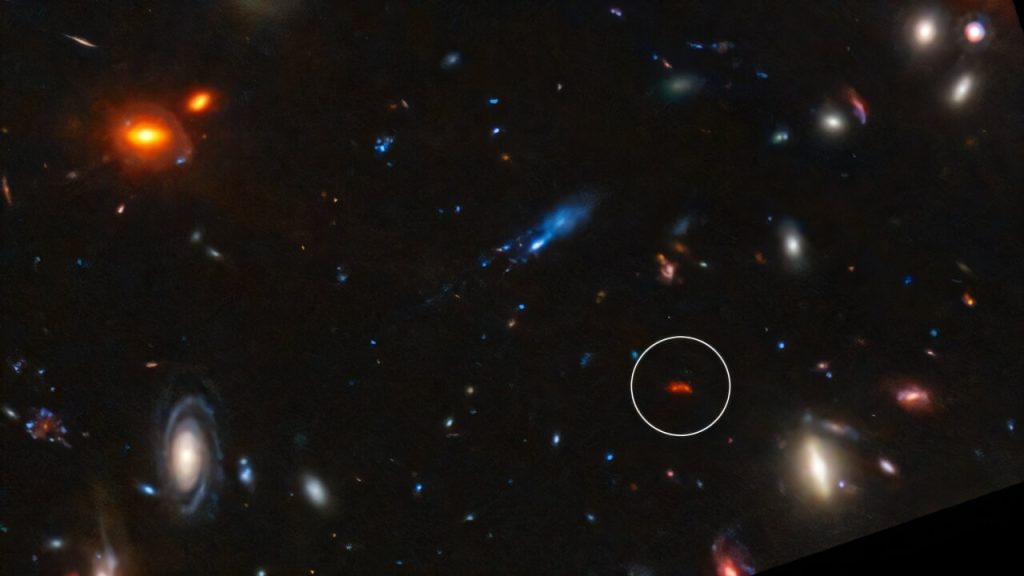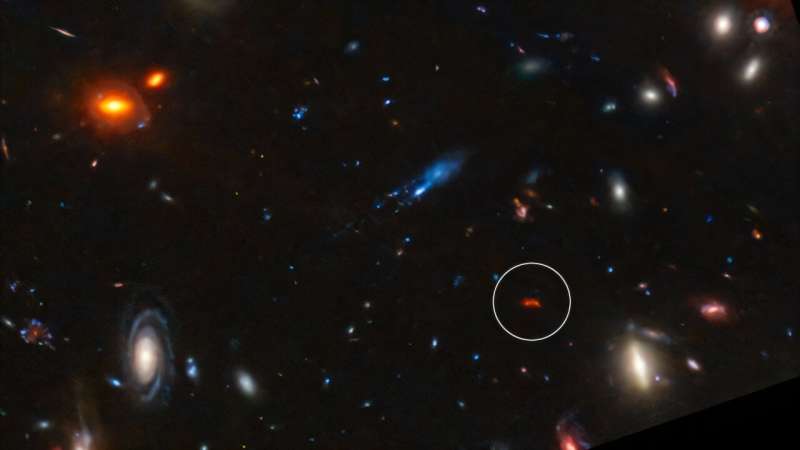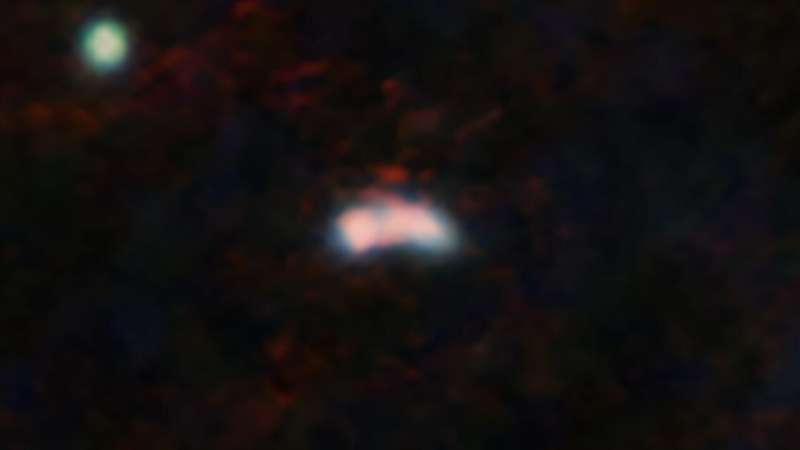A newly found superheated star formation region from the early universe.

Superheated star factory discovered in early universe (Image Credit: Phys.org)

The discovery of a superheated star factory that forms stars 180 times faster than our own Milky Way could help solve a long-standing puzzle about how galaxies grew so quickly in the early universe.
Astronomers uncovered the previously unknown, extreme kind of star factory by taking the temperature of a distant galaxy glowing intensely in superheated cosmic dust.
The first generations of stars formed under conditions very different from anywhere we can see in the nearby universe today, which is why the new research published in the Monthly Notices of the Royal Astronomical Society is so fascinating.
Experts are studying these differences using powerful telescopes such as the ALMA telescope, which can detect galaxies so far away their light has taken billions of years to reach us.
In the study, an international team of astronomers led by postdoctoral researcher Tom Bakx, of Chalmers University of Technology in Sweden, measured the temperature of one of the most distant-known star factories.
The galaxy, known as Y1, is so far away that its light has taken more than 13 billion years to reach us. Known by its catalogue number, MACS0416_Y1, it lies so far from Earth that its light is stretched out by the expansion of the universe; astronomers refer to its distance as redshift 8.3. It was discovered behind a cluster of galaxies called MACS0416, which itself lies only 4 billion light years away in the direction of the constellation Eridanus, the River.
“We’re looking back to a time when the universe was making stars much faster than today,” said Bakx. “Previous observations revealed the presence of dust in this galaxy, making it the farthest away we’ve ever directly detected light from glowing dust.
“That made us suspect that this galaxy might be running a different, superheated kind of star factory. To be sure, we set out to measure its temperature.”
Stars like our sun are forged in huge, dense clouds of gas in space. The Orion Nebula and the Carina Nebula are two examples of such star factories. They shine brightly in the night sky, powered by their youngest and most massive stars, which light up clouds of gas and dust in many different colors.
At wavelengths longer than the human eye can see, star factories shine brightly thanks to huge numbers of tiny grains of cosmic dust, heated by starlight.
To be able to probe the galaxy’s temperature, the scientists needed the superior sensitivity of ALMA. One of the world’s largest telescopes, ALMA’s dry, high-altitude location made it possible to image the galaxy in just the right color, at a wavelength of 0.44 millimeters using its Band 9 instrument.

“At wavelengths like this, the galaxy is lit up by billowing clouds of glowing dust grains. When we saw how bright this galaxy shines compared to other wavelengths, we immediately knew we were looking at something truly special,” Bakx added.
The detection showed the galaxy’s dust glowing at a temperature of 90 Kelvin—around -180°C.
“The temperature is certainly chilly compared to household dust on Earth, but it’s much warmer than any other comparable galaxy we’ve seen,” said co-researcher Yoichi Tamura, an astronomer at Nagoya University in Japan.
“This confirmed that it really is an extreme star factory. Even though it’s the first time we’ve seen a galaxy like this, we think that there could be many more out there. Star factories like Y1 could have been common in the early universe.”
Y1 is manufacturing stars at the extreme rate of more than 180 solar masses per year, an unsustainable pace that cannot last long on cosmological scales. On average, our galaxy, the Milky Way, creates only about one solar mass per year.
But scientists suspect that brief, hidden bursts of star formation, as seen in Y1, may have been common in the early universe.
“We don’t know how common such phases might be in the early universe, so in the future we want to look for more examples of star factories like this. We also plan to use the high-resolution capabilities of ALMA to take a closer look at how this galaxy works,” said Bakx.
His team believes that galaxy Y1 may help solve another cosmic mystery. Earlier studies have shown that galaxies in the early universe appear to have far more dust than their stars could have produced in the short time they have been shining.
Astronomers have been puzzled by this, but Y1’s unusual temperature points to a solution.
“Galaxies in the early universe seem to be too young for the amount of dust they contain. That’s strange, because they don’t have enough old stars, around which most dust grains are created,” said fellow researcher Laura Sommovigo, of the Flatiron Institute and Columbia University in the U.S.
“But a small amount of warm dust can be just as bright as large amounts of cool dust, and that’s exactly what we’re seeing in Y1. Even though these galaxies are still young and don’t yet contain much heavy elements or dust, what they do have is both hot and bright.”
More information:
Tom Bakx et al, A warm ultraluminous infrared galaxy just 600 million years after the big bang, Monthly Notices of the Royal Astronomical Society (2025). DOI: 10.1093/mnras/staf1714
Journal information:
Monthly Notices of the Royal Astronomical Society
Provided by
Royal Astronomical Society
Superheated star factory discovered in early universe (2025, November 12)
retrieved 12 November 2025
from https://phys.org/news/2025-11-superheated-star-factory-early-universe.html
part may be reproduced without the written permission. The content is provided for information purposes only.




